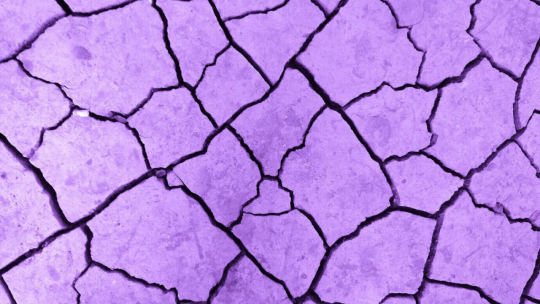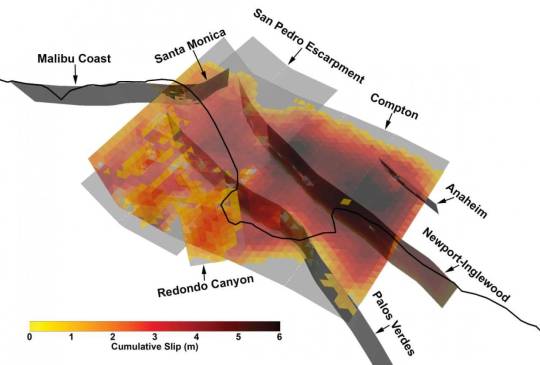#scec
Explore tagged Tumblr posts
Text
Oh hey, Californians, remember that SCEC simulation of The Big one that launched the Great Shake Out drills in the mid-2000s?
youtube
They've refined the models now so you can get an idea what you're in for when that really constipated span of the San Andreas lets go.
There's a playlist of locations from Ventura and downtown LA to Riverside and Palm Springs!
Here's my neck of the woods. I'm cowering in that yellow area at upper right shielded by a spur of the mountains...
youtube
@spacetimeconundrum

Looking at where the Santa Ana river cuts through the mountains and makes a flat basin of sediment around Anaheim, i'm not sure that Disneyland will be the happiest place on earth. (But the ride should be interesting!) 
7 notes
·
View notes
Text
90% delle volte nella vita ci inventiamo dei limiti per poi poterne soffrire ma si sa, è così cool essere tormentati con 1000 casini piuttosto che tranquilli e felici
che bo tep scec
0 notes
Text
Elbit America Awarded US Army Contract to Produce Integrated Headborne Sensor System
Elbit Systems of America (Elbit America) received an Other Transaction Authority contract from SOSSEC, Inc., through the Sensors, Communication, and Electronics Consortium (SCEC), to produce the Integrated Headborne Sensor System (IHSS) prototype for dismounted Soldiers in the United States Army. Elbit America’s IHSS is a wearable system, allowing Soldiers to remain mobile, while they acquire, share, and utilize critical information on the battlefield. The system fuses a myriad of sensors into a lightweight Head Up Display that provides unprecedented situational awareness. Elbit America’s prototype evolves through three prototype development phases during a 72-month period.
Elbit Systems of America (Elbit America) received an Other Transaction Authority contract from SOSSEC, Inc., through the Sensors, Communication, and Electronics Consortium (SCEC), to produce the Integrated Headborne Sensor System (IHSS) prototype for dismounted Soldiers in the United States Army. Elbit America’s IHSS is a wearable system, allowing Soldiers to remain mobile, while they acquire,…

View On WordPress
0 notes
Link
[ad_1] Newswise — There is a rumbling in the seismic research community. Current studies about earthquake rupture forecasts or ERFs provide information about the probabilities of when earthquakes will occur, where they’ll take place and how strong they will be. But advanced physics-based models that track fault system evolution backed up by observations are not accessible to a wide scientific community, which reduces the pace of research advancements and delays the benefits to society.So scientists from the Southern (transitioning to Statewide) California Earthquake Center (SCEC) at the University of Southern California (USC), the San Diego Supercomputer Center (SDSC) and the Scripps Institution of Oceanography (Scripps) at UC San Diego, and the University of Illinois Urbana-Champaign (UIUC) formed a team to address the problem. Their proposal to create a new science gateway for the community of researchers who study ERFs caught the attention of the National Science Foundation’s Office of Advanced Cyberinfrastructure, which awarded the project a five-year $2.5 million grant.The team for this collaborative grant award includes the project’s Lead Principal Investigator (PI) from SCEC/USC, Yehuda Ben-Zion; SDSC/UC San Diego PI Amit Chourasia and Scripps/UC San Diego Co-PI Alice-Agnes Gabriel, and UIUC PI Ahmed Elbanna.With goals to advance the science of ERFs, obtain new insights on earthquake physics, improve seismic hazard estimates and provide new opportunities for STEM education and engagement, the team will create a cyberinfrastructure platform for the broad community to easily use computational tools and access data. Named Quakeworx, the science gateway will provide access to state-of-the-art methods for physics-based simulations and data analysis. It will host standardized pipelines for advanced simulations, facilitate data assimilation to inform and validate models on demand and enable machine-learning pattern recognition analyses on big datasets. “Quakeworx will accelerate innovation in earthquake science by enabling generation of diverse outputs such as seismicity, ground motion, fault network configuration, strain rates and topography that can be used to validate model results, improve ERFs and discover new patterns,” said Ben-Zion, director of SCEC and professor of Earth Sciences at USC Dornsife College of Letters, Arts and Sciences. “We anticipate the project to be transformational in research of earthquakes and faults, while contributing to modernizing education and facilitating translation of results to society at large.”Ben-Zion noted that the project will enable large-scale simulations of coupled evolution of earthquakes and faults for the first time. “Quakeworx will curate and seed many leading simulation tools and data products that leverage existing SCEC’s community data models describing fault and rock properties as simulation input,” he said.According to Chourasia, associate director for the S3 Division at SDSC, who leads the gateway cyberinfrastructure effort, Quakeworx will build upon and improve existing NSF investments such as Hubzero®, OneSciencePlace®, Tapis and SeedMeLab. It will provide a platform to curate state-of-the-art simulators and machine learning applications in seismology that could be easily executed on a variety of local and remote computation resources such as those available at SDSC and from NSF’s ACCESS program. Overall, Quakeworx will deliver an innovative, service-oriented and easy-to-use cyberinfrastructure to a large user community.“The developed Quakeworx gateway will enable the community to contribute, curate and share tools for simulations, data analysis and visualization, data products and knowledge base on an open platform. It will provide a foundation that provides build-once-and-reuse-for-all that eliminates barriers to lack of expertise and lack of access to compute resources,” said Chourasia, who is also the director of Hubzero, adding that the Quakeworx framework will support extensibility through a pluggable architecture and composability with other systems and include first-class implementation that makes content FAIR (Findable, Accessible, Interoperable, Reusable).Gabriel, associate professor at the Institute of Geophysics and Planetary Physics at Scripps, and Elbanna, associate professor and the Donald Biggar Willett Faculty Fellow at UIUC, will lead the development and integration of several physics-based Next Generation Earthquake Simulators, including the current NSF Leadership-Class Computing Facility application SeisSol, utilizing high-performance computing for the project. They noted that the reduction in barriers to the use of computational methods in earthquake research will be achievable with the Quakeworx gateway that is designed to simplify access to state-of-the-art research software, compute and storage resources.They will also lead together with Ben-Zion the development and integration of machine learning apps for the project, and they said further that Quakeworx will enable rapid immersion of students, post-doctoral fellows and early career scientists with state-of-the-art simulation and analysis tools. This democratization of access will aid in modernizing education and training in earthquake physics, computational modeling, software engineering and related fields.The project will engage and mentor four postdoctoral fellows, six graduate students, 15 undergraduates and 10 professionals. Ben-Zion explained that SCEC’s role in the project is to coordinate the science needed to develop and extract information from the next generation earthquake simulations, while SDSC’s role is to develop the computational gateway needed to support the next generation simulations and data analyses.Broader impacts of the project include:Contributing to the development of a more resilient society to earthquakes, including working to provide critical information for emergency services and design of rapid follow-up scientific studies after large earthquakes;Sharing of key results and services with the broad earthquake community including academic institutions, federal and state agencies, and the private sector, as well as translation of advanced computational research into publicly available scientific information; andEnabling workforce development and community engagement via mentoring, training workshops and dissemination of results through conferences and scholarly articles.According to the team, the project contributes to the national interest by supporting a more resilient society with improved capabilities for forecasting earthquakes and assessing seismic hazard, which are foundational for mitigation of seismic risk, contributing to STEM workforce development and facilitating translation of results to the society at large.Support for this project is from the NSF (grant awards nos. 2311206, 2311207 and 2311208). window.fbAsyncInit = function () FB.init( appId: '890013651056181', xfbml: true, version: 'v2.2' ); ; (function (d, s, id) var js, fjs = d.getElementsByTagName(s)[0]; if (d.getElementById(id)) return; js = d.createElement(s); js.id = id; js.src = " fjs.parentNode.insertBefore(js, fjs); (document, 'script', 'facebook-jssdk')); [ad_2]
0 notes
Text
youtube
Fully licensed, insured and accredited with SCEC and MLAA, Key Solution Locksmiths is a 5 star rated business.
0 notes
Text
Naturalisation suivi dossier 2022 : Délais, décision, recours.
Naturalisation suivi dossier 2022 : Délais, décision, recours.
Naturalisation suivi dossier 2022 : Délais, décision, recours. Avant de commencer : – Rejoignez notre Forum en cliquant ici.– Rejoignez notre groupe Facebook en cliquant ici.– Utilisez notre outil de recherche de décret de naturalisation.– Retrouvez la liste complète des décrets de naturalisation 2022 parus dans le Journal Official en cliquant ici.Vous pourrez ainsi facilement retrouver votre…

View On WordPress
#décret naturalisation#decret naturalisation journal officiel#Naturalisation#naturalisation acte de naissance#naturalisation contact#naturalisation démarche#naturalisation JO#naturalisation journal officiel#naturalisation ministere#Naturalisation par décret#naturalisation par décret 2021#naturalisation par decret delais#naturalisation par decret documents#naturalisation prefecture#naturalisation scec#naturalisation suivi dossier#nauturalisation dossier
0 notes
Link
Safeguard Locksmiths are scec endorsed and offers 24-hour emergency locksmith services, including key cutting and lock repair and replacement. Call now!
1 note
·
View note
Link
SCEC Endorsed High Security Master Key Systems to meet SL3 Level. We have been responsible for the design and installation of some of the biggest master key systems in Australia including high security SCEC Endorsed locking systems for Government and Defense departments. We are a preferred and authorized security provider of SCEC approved products and we have hundreds of National clients who are security cleared to regularly purchase approved SCEC Endorsed equipment and we are also the custodians of many large SCEC Endorsed high security SL3 level master key systems for Government and Defense departments and Customs and Border Protection Offices Australia wide which we control and monitor from our Melbourne Head Office. Some SCEC endorsed SL3 level locking systems include New Generation Bi-Lock, Abloy Protect 2, EVVA 3KS Plus, MT5+, Galaxy, and BiLock Exclusive to name a few.
1 note
·
View note
Text

I should not have Tooted

#about 50 roll and no horn#guess it’s time to convert these rocks to start saving up for Scec#no more wasting LMD for lore
7 notes
·
View notes
Text

SCEC conference registration form is on point
4 notes
·
View notes
Text
Visualizing Mythology: Using Universal Design for Learning to Teach Greek Mythology


Sketch note of Homeric Hymn to Demeter. Cc-BY Alison Innes @InnesAlison
CAC/SCEC McMaster University 7 May 2019
Lianne Fisher, Centre for Pedagogical Innovation, Brock University Email: [email protected] Twitter: @liannefisher
Alison Innes, Brock University Email: [email protected] Twitter: @innesalison
The relationship between learning, note taking and class preparation is not always articulated,…
View On WordPress
#cac-scec#classics#Cornell Notes#pedagogy#sketchnote#teaching#UDL#Universal design for learning#visual notes taking
0 notes
Text
The sunset lesbian flag
By: @x-mogai-glitch-x
I know theres like 3 bajillion lesbian flags already but as a butch aroace-spec cusper disabled he/they indiginous system lesbian myself, i felt really disconnected from most lesbian flags i find. They are mostly pink which is a dysphoric color for me as a non-binary individual and most dont explicitly include lesbians like me for butchphobic, aphobic, trans/enbyphobic, ablesit, racist or pncphobic reasons which is not the kind of things id want to be used to represent me so i made my own lesbian flag that i think ill call the sunset lesbian flag! Its got 6 stripes and i also made the usual 7 stripe lesbian varient as well.
Heres the basic sunset lesbian flag, i tried to make it easier on the eyes:

The stripes represent many facets of lesbianism:
1. (Stone/high/soft/king) butches, (stone/high/soft/king) studs and (stone/high/soft/king) ags
2. Aro/aro-spec, ace/ace-spec and aroace/aroace-spec lesbians
3. Trans, nonbinary, two-spirit and cusper lesbians
4. Disabled, Neurodiverse and system lesbians
5. He/him, they/them, neopronouned and emoji pronouned lesbians
6. (Stone/high/tom/queen) femme lesbians

Heres the 7-stripe varient to match the typical lesbian flags. All through this white stripe's meanings are also in the flag above, its not so explicitly expressed.
The white stripe here means: love of women and non-binary people as women and nonbinary.
I also made versions based on presentations just to match as well as 7 stripe versions:
Feminine lesbian( not explicitly femme as they dont mean the same as feminine in this context.)

1. (Stone/high/soft) butches,(stone/high/soft) studs, (stone/high/soft) ags
2. Fem/clover/solomans seal aro/aro-scec, fem/violet/orchid ace/ace-spec, fem/sakura/maple aroace/aroace-spec lesbians
3. Fem Trans, fem nonbinary, fem cusper and fem Two-spirit ( note: this is feminine in presentation, not inherently feminine in gender) lesbians
4. Fem disabled, fem neurodiverse, fem system lesbians
5. Fem he/him, fem they/them, fem neopronouned and fem emoji pronouned lesbians
6.(stone/high/queen) femme lesbians

7-stripe varient
Masculine lesbian( not explicitly butch as they dont mean the same as masculine in this context.)

1. (Stone/high/king) butches, (stone/high/king) studs, (stone/high/king) ags
2. Masc/larch/solomans aro/aro-spec, masc/ bluebell/orchid ace/ace-spec, masc/juniper/maple aroace/aroace-spec lesbians
3. Masc trans, masc non-binary, masc cusper and masc two spirit( note: this is masculine in presentation, not inherently masculine in gender) lesbians
4. Masc disabled, masc neurodiverse, Masc system lesbians
5. Masc he/him, masc they/them, masc neopronouned and masc emoji pronouned lesbians
6. (stone/high/tom) femme lesbians

7 stripe varient
Androgynous lesbian (specifically genderless-presenting.)

1. (Stone/high) butches, (stone/high) studs, (stone/high) ags
2. Andro/thyme aro/aro-spec, andro/lilac ace/ace-spec, andro/aspen aroace/aroace-spec lesbians
3. Andro trans, andro non-binary, andro cusper and andro two spirit( note: this is androgynous in presentation, not inherently androygne in gender) lesbians
4. Andro disabled, andro neurodiverse, andro system lesbians
5. Andro he/him, andro they/them, andro neopronouned and andro emoji pronouned lesbians
6. (stone/high) femme lesbians

7 stripe varient
Mixed/multi/fluid/flux/fluxid lesbian (specifically presention.)

1. (Stone/high) butches, (stone/high) studs, (stone/high) ags
2. Mix/solomans aro/aro-spec, mix/orchid ace/ace-spec, mix/maple aroace/aroace-spec lesbians
3. Mix trans, mix non-binary, mix cusper and mix two spirit( note: this is mixed/multi/flow/flux/fluxid in presentation, not inherently in gender) lesbians
4. Mix disabled, mix neurodiverse, mix system lesbians
5. Mix he/him, mix they/them, mix neopronouned and mix emoji pronouned lesbians
6. (stone/high) femme lesbians

7 stripe varient
Finally thoughts: this lesbian flag operates under this definition.
This flag is open to all lesbians regardless of age, gender, race, ethnicity or status. It includes polyamorous, otherkin and sex worker lesbians.
#sunset lesbian flag#mogai community#mogai friendly#mogai term#pro mogai#mogaireal#clover terms#lesbian#lesbian flag#new lesbian flag#inclusive lesbian flag
37 notes
·
View notes
Text
Simulating thousands of years of California earthquake history to assess risks

- By Aaron Dubrow , University of Texas at Austin -
Massive earthquakes are, fortunately, rare events. But that scarcity of information blinds us in some ways to their risks, especially when it comes to determining the risk for a specific location or structure.
"We haven't observed most of the possible events that could cause large damage," explained Kevin Milner, a computer scientist and seismology researcher at the Southern California Earthquake Center (SCEC) at the University of Southern California. "Using Southern California as an example, we haven't had a truly big earthquake since 1857 — that was the last time the southern San Andreas broke into a massive magnitude 7.9 earthquake. A San Andreas earthquake could impact a much larger area than the 1994 Northridge earthquake, and other large earthquakes can occur too. That's what we're worried about."
The traditional way of getting around this lack of data involves digging trenches to learn more about past ruptures, collating information from lots of earthquakes all around the world and creating a statistical model of hazard, or using supercomputers to simulate a specific earthquake in a specific place with a high degree of fidelity.
However, a new framework for predicting the likelihood and impact of earthquakes over an entire region, developed by a team of researchers associated with SCEC over the past decade, has found a middle ground and perhaps a better way to ascertain risk.
A new study led by Milner and Bruce Shaw of Columbia University, published in the Bulletin of the Seismological Society of America in January 2021, presents results from a prototype Rate-State earthquake simulator, or RSQSim, that simulates hundreds of thousands of years of seismic history in California. Coupled with another code, CyberShake, the framework can calculate the amount of shaking that would occur for each quake. Their results compare well with historical earthquakes and the results of other methods, and display a realistic distribution of earthquake probabilities.

Image: 3D view of one especially complex multi-fault rupture from the synthetic earthquake catalog. Credit: Kevin Milner, University of Southern California.
According to the developers, the new approach improves the ability to pinpoint how big an earthquake might occur in a given location, allowing building code developers, architects, and structural engineers to design more resilient buildings that can survive earthquakes at a specific site.
"For the first time, we have a whole pipeline from start to finish where earthquake occurrence and ground-motion simulation are physics-based," Milner said. "It can simulate up to 100,000s of years on a really complicated fault system."
Applying massive computer power to big problems
RSQSim transforms mathematical representations of the geophysical forces at play in earthquakes — the standard model of how ruptures nucleate and propagate — into algorithms, and then solves them on some of the most powerful supercomputers on the planet. The computationally-intensive research was enabled over several years by government-sponsored supercomputers at the Texas Advanced Computing Center, including Frontera — the most powerful system at any university in the world — Blue Waters at the National Center for Supercomputing Applications, and Summit at the Oak Ridge Leadership Computing Facility.
"One way we might be able to do better in predicting risk is through physics-based modeling, by harnessing the power of systems like Frontera to run simulations," said Milner. "Instead of an empirical statistical distribution, we simulate the occurrence of earthquakes and the propagation of its waves."
"We've made a lot of progress on Frontera in determining what kind of earthquakes we can expect, on which fault, and how often," said Christine Goulet, Executive Director for Applied Science at SCEC, also involved in the work. "We don't prescribe or tell the code when the earthquakes are going to happen. We launch a simulation of hundreds of thousands of years, and just let the code transfer the stress from one fault to another."
The simulations began with the geological topography of California and simulated over 800,000 virtual years how stresses form and dissipate as tectonic forces act on the Earth. From these simulations, the framework generated a catalogue — a record that an earthquake occurred at a certain place with a certain magnitude and attributes at a given time. The catalog that the SCEC team produced on Frontera and Blue Waters was among the largest ever made, Goulet said. The outputs of RSQSim were then fed into CyberShake that again used computer models of geophysics to predict how much shaking (in terms of ground acceleration, or velocity, and duration) would occur as a result of each quake.
"The framework outputs a full slip-time history: where a rupture occurs and how it grew," Milner explained. "We found it produces realistic ground motions, which tells us that the physics implemented in the model is working as intended." They have more work planned for validation of the results, which is critical before acceptance for design applications.
youtube
Video: “3000 Years of California Quakes - Scientific Visualization” by TACCutexas, YouTube.
The researchers found that the RSQSim framework produces rich, variable earthquakes overall – a sign it is producing reasonable results – while also generating repeatable source and path effects.
"For lots of sites, the shaking hazard goes down, relative to state-of-practice estimates" Milner said. "But for a couple of sites that have special configurations of nearby faults or local geological features, like near San Bernardino, the hazard went up. We are working to better understand these results and to define approaches to verify them."
The work is helping to determine the probability of an earthquake occurring along any of California's hundreds of earthquake-producing faults, the scale of earthquake that could be expected, and how it may trigger other quakes.
Support for the project comes from the U.S. Geological Survey (USGS), National Science Foundation (NSF), and the W.M. Keck Foundation. Frontera is NSF's leadership-class national resource. Compute time on Frontera was provided through a Large-Scale Community Partnership (LSCP) award to SCEC that allows hundreds of U.S. scholars access to the machine to study many aspects of earthquake science. LSCP awards provide extended allocations of up to three years to support long-lived research efforts. SCEC – which was founded in 1991 and has computed on TACC systems for over a decade — is a premier example of such an effort.
The creation of the catalog required eight days of continuous computing on Frontera and used more than 3,500 processors in parallel. Simulating the ground shaking at 10 sites across California required a comparable amount of computing on Summit, the second fastest supercomputer in the world.
"Adoption by the broader community will be understandably slow," said Milner. "Because such results will impact safety, it is part of our due diligence to make sure these results are technically defensible by the broader community," added Goulet. But research results such as these are important in order to move beyond generalized building codes that in some cases may be inadequately representing the risk a region face while in other cases being too conservative.
"The hope is that these types of models will help us better characterize seismic hazard so we're spending our resources to build strong, safe, resilient buildings where they are needed the most," Milner said.
--
Source: University of Texas at Austin
Full study: “Toward Physics‐Based Nonergodic PSHA: A Prototype Fully Deterministic Seismic Hazard Model for Southern California”, Bulletin of the Seismological Society of America.
https://doi.org/10.1785/0120200216
Read Also
New AI detects 17 times more earthquakes than mainstream frameworks
1 note
·
View note
Text
Askwith Safe Company
Askwith Safe Company is a Safe and vault shop in Welshpool. We offer a range of home & office safes, commercial safes, deposit safes, data & document safes, gun safes, drug and pharmaceutical safes, key cabinets, cash tins, second hand safes and refurbished safes. We offer safe services including scec locksmith, safe relocation, safe delivery and installation, safe maintenance, safe repairs and safe servicing. Located in Welshpool we service the greater south west Perth area including Kewdale, Cloverdale, Belmont, Lathlain, Carlisle, Victoria Park, Kensington, East Victoria Park, Bentley, Qeens Park, Cannington, Beckenham, Kenwick, Wattle Grove and Forrestfield. executive safe
1 note
·
View note
Photo

Earthquake Right Now Readiness - Online California Homeowner Sources
Earthquakes right now occur in California. Over 100 problems within the condition produce a large number of quakes every year. The biggest fault may be the San Andreas Fault, which runs for countless miles up and lower California.
Discovered with a UC Berkeley geology professor in 1895, the San Andreas Fault continues to be accountable for large quakes (above 6.) occurring in Monterey County roughly every 22 years. The final large quake hit the region in 2004.
Inside a 2006 earthquake study, geophysicist Yuri Fialko figured that San Andreas Fault levels of stress have again elevated, which the fault is prepared for the following "big one," an earthquake having a magnitude of seven. or greater.
Fialko also noted that giant quakes haven't happened in southeast the fault (San Bernardino, Riverside and Imperial counties) for more than 300 years. The final large quake in La County was the magnitude 6.7 Northridge earthquake in 1994, which caused over 60 fatalities, 8,700 injuries, and also the structural failure of structures, parking structures and freeways.
Most Californians understand the possible dangers of a big quake, for example ground movement and displacement, flooding and fire. Many condition residents have took part in earthquake readiness programs to improve their likelihood of survival once the big one finally hits. However, it had been present in a 2010 California Earthquake Readiness Survey, that "Californians in high-risk areas won't be preparing compared towards the differential risks they face."
Also, regardless of the potential damage that may be the result of a major quake, under 20% of California homeowners have earthquake insurance. Some think that if their house managed to get with the last big quake, it'll survive the following. However, based on a La Occasions article, "some respected earthquake researchers are themselves investing in earthquake retrofitting instead of having to pay for insurance policy."
Earthquake retrofitting constitutes a structure more resistive to seismic activity. Techniques include house bolting as well as other structural enhancements for additional security and stability. A retrofitting can't only minimize earthquake damage, it can make your building safer for occupants.
There are lots of online sources to assist California residents, including homeowners, with earthquake readiness, such as the California Seismic Safety Commission ( http://world wide web.seismic.ca.gov/ ), Los Angeles Earthquake Center (SCEC) ( http://world wide web.scec.org/ ) and Federal Emergency Management Agency (FEMA).
The California Seismic Safety Commission has a number of info on earthquakes, in addition to several publications. The Commission researches and investigates earthquakes.
The SCEC, found at the College of Los Angeles, is definitely an organization of scientists and students having a special concentrate on Los Angeles earthquakes. SCEC publications include Seismic Hazards in Los Angeles and Putting Lower Roots in Earthquake Country, containing an extensive section on earthquake readiness. The guide obtainable both in British and Spanish.
There's additionally a exclusive edition for that San Fran.
The California Emergency Management Agency (CalEMA) is yet another organization involved with earthquake readiness, and it is an organizer from the Great California ShakeOut.
To determine if your house is earthquake ready, consult a skilled earthquake readiness foundation contractor. They are able to perform a foundation inspection and find out what must be completed to safeguard your house.
1 note
·
View note
Photo

Helping out at St. Croix Educational Complex with STEM program. Drone Project.. #stem #stemeducation #scec #school #summerprogram #drone #fpvlife #dronelife #education (at St. Croix Educational Complex High School)
0 notes